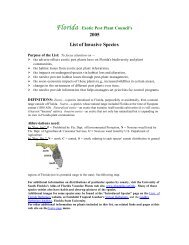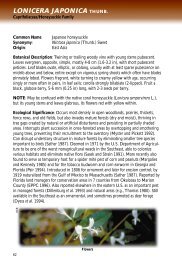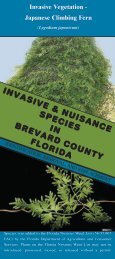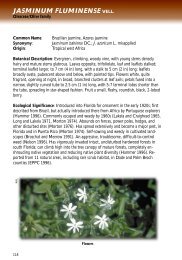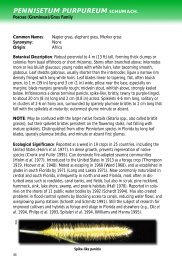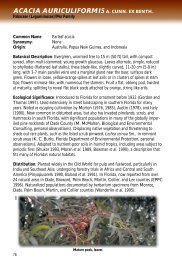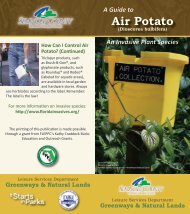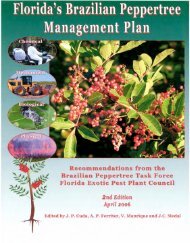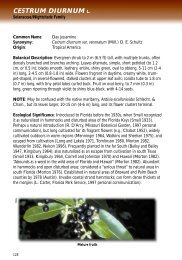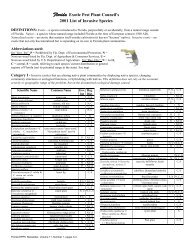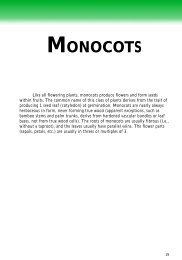DICOTS - Florida Exotic Pest Plant Council
DICOTS - Florida Exotic Pest Plant Council
DICOTS - Florida Exotic Pest Plant Council
You also want an ePaper? Increase the reach of your titles
YUMPU automatically turns print PDFs into web optimized ePapers that Google loves.
Senna pendula (Willd.) Irwin & Barn. var. glabrata<br />
Fabaceae (Leguminosae)/Pea Family<br />
(Vogel) Irwin & Barn.<br />
Common Names: Climbing cassia, Christmas cassia, Christmas senna, cassia shrub<br />
Synonymy: Cassia coluteoides Coll.; C. bicapsularis L. and C. surattensis<br />
Burm. f. misapplied<br />
Origin: South America<br />
Botanical Description: Sprawling evergreen shrub to 4 m (13 ft) tall (or wide), with<br />
somewhat zigzag, sparsely hairy stems. Leaves alternate, stalked, even-pinnately compound,<br />
with 3-6 pairs of leaflets, larger ones at leaf tip; leaflets to 4 cm (1.6 in) long,<br />
oblong with rounded tips; petioles with gland above, between lowermost leaflets (and<br />
occasionally between others). Flowers yellow or yellow-green, 3-4 cm (1.2-1.6 in) across,<br />
in 3- to 12-flowered racemes near stem tips; stamens with prominent, curved filaments.<br />
Fruit a brown slender pod, cylindric, glabrous, 7-12 cm (3-5 in) long.<br />
Ecological Significance: Briefly noted by Small (1933) as seen in south <strong>Florida</strong>. Commonly<br />
cultivated for ornament in <strong>Florida</strong> at least since the 1940s (Bailey and Bailey<br />
1947). Described as fast and rank in its growth (Maxwell and Maxwell 1961). Observed<br />
in the wild in south <strong>Florida</strong> since the early 1970s (D. F. Austin, <strong>Florida</strong> Atlantic University,<br />
1995 personal communication). Noted as naturalized in south <strong>Florida</strong>, and becoming<br />
weedy in the Bahamas and disturbed areas in South America (Irwin and Barneby<br />
1982) and as moderately established outside cultivation in <strong>Florida</strong> by 1990 (Isely).<br />
Displaces native vegetation in disturbed and undisturbed areas of <strong>Florida</strong>’s tropical<br />
hammocks, coastal strands, and canal banks (M. Renda, The Nature Conservancy, 1996<br />
personal communication). Often becomes established in sunny openings and then<br />
clambers over adjacent canopy (Austin 1998). Reported from scrub and forest natural<br />
areas in Palm Beach County and from the edge of Lake Okeechobee in Hendry County<br />
(EPPC 1996).<br />
Distribution: Native to Brazil, Peru, through Bolivia and south to Paraguay and Argentina;<br />
naturalized in the Bahamas and <strong>Florida</strong>, and probably also in southern Alabama,<br />
Louisiana, and Mississippi (Isely 1990). Cultivated in all regions of <strong>Florida</strong> (Hunt 1977,<br />
Nelson 1996). Often sold as C. bicapsularis (Isely 1990). Documented by herbarium<br />
records from peninsular <strong>Florida</strong>, from Hillsborough and Brevard south to Dade and<br />
Collier counties (Wunderlin et al. 1995).<br />
KAL<br />
88<br />
In Lake Jessup conservation area



